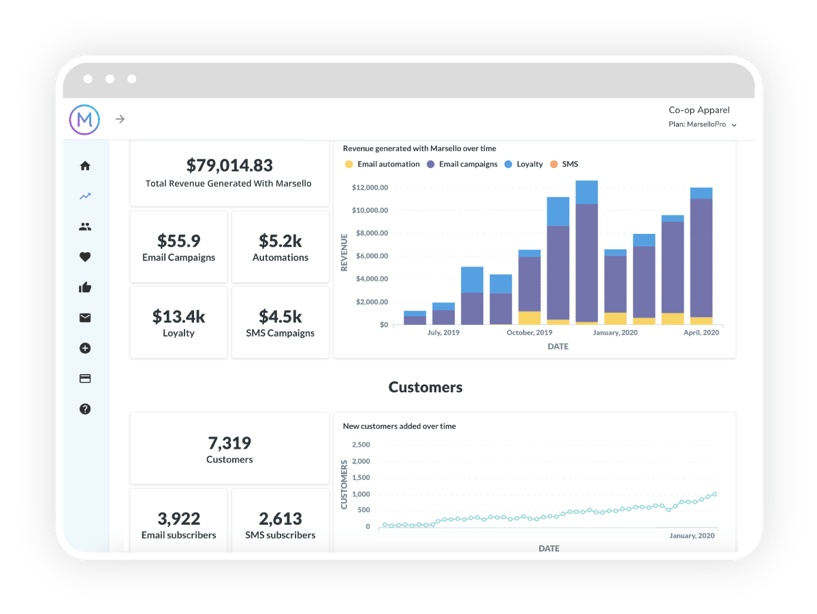
Cross-platform marketing is becoming an essential part of any marketing strategy as customers become more diverse and move between more platforms as part of their buyer journey. Understanding how to make the most of this approach will allow you to have more positive engagements with your customers, leading to a higher rate of return.
There are certain challenges to be aware of when it comes to starting out in cross-platform marketing. However, there are also specific benefits that you aren’t able to achieve through more static, siloed approaches. Understanding both of these will help you develop effective strategies that help you create more enjoyable interactions for your customers.
What is cross-platform marketing?

Cross-platform marketing creates an integrated experience for your customers. They are able to move between platforms such as your social media, eCommerce website, marketplaces, and physical stores during their research and purchase process. Information is maintained and integrated as they move, providing a tailored experience that feels like one fluid representation of your brand.
The key difference between this and multi-platform marketing is that the emphasis is on allowing customers to move seamlessly between platforms. With cross-platform marketing, the messaging is not statically held in silos, instead, it adapts to the needs of the customers. The customer, not the product, is the center of the marketing activities.
What are the common challenges of cross-platform marketing
Before you begin building a cross-platform marketing strategy, it’s important to understand the challenges that you’re likely to face. This can help you better prepare for them and still achieve success with your strategy.
Cross-platform marketing is more complicated than single-platform marketing by its very nature. This means you need to spend more time considering how to reach the right users at the right time. With a huge array of platforms available, it can be hard to predict where customers are going to be and when. You will need to learn how your ideal customers use your key platforms and use this information to inform your marketing strategy. . What works well as a television commercial won’t necessarily translate into a TikTok video.
In the digital age, there seem to be endless amounts of data to process. However, the quality of this data isn’t always as high as marketers would like. Without a cross-channel marketing platform to bring all of this data into one place, it can be challenging to integrate it well. This also influences knowing the right channels to advertise on.
With cross-platform marketing, attribution can become more tricky. As the customer moves between multiple platforms, it is difficult to define which tactic was responsible for the sale. A more holistic view of attribution must be used, knowing that all tactics contribute towards sales.
7 cross-platform marketing tips to help boost leads

Often, the hardest part of creating a marketing strategy is knowing where to start. Your cross-platform marketing strategy will go a long way by understanding your customers and where they will engage with your brand most. Read our 7 tips to get a good grasp of how to implement a really solid strategy.
1. Make use of buyer personas
By building buyer personas, you’re able to better understand your potential and existing customers. Using real data and insights, you can better understand what segments of your market are motivated by and interested in. This flows through into the content you create and the platforms you show up on.
To create a buyer persona begin with gathering data on the types of people you want to include. Again, this should include existing as well as potential customers. As you bring all of this together, look for commonalities. This includes demographics, purchasing behavior, ways of consuming content, and preferred platforms. A great way to get started is to couple your analytics data and paid advertising to create demographic-based segments from your current customers and create look-a-like audiences, refining your ad group segments as you iterate. You can assume these customers are more likely to convert than more generalized ad groups because they have similar ‘attributes’ to your current customers.
2. Use platforms that resonate with your users
There is an ever-growing list of platforms that you can use to market to your customers. Understanding which of these your target markets are using ensures that you’re selecting the correct cross-channel marketing platforms. These include email marketing, SMS, your website, social media channels, news or information websites, and more.
When building your buyer personas, consider platform selection as part of this process. This will allow you to build customer journeys that move across the right platforms for the right customers in a way that feels natural and fluid. You can then also create content that is platform-specific and relevant.
3. Use a single platform to analyze all your data

When creating content and customer journey’s that move across multiple platforms, there can be vast amounts of interrelated data to report. Although you can’t attribute sales to a single platform or interaction, you want to be able to see all of the interactions that lead up to a sale.
This is why using a single platform to analyze your cross-channel marketing data can simplify your reporting. Having one source of truth that can track your customers between platforms and through the entire journey makes reporting more accurate. Marsello’s integrated platform can help monitor the entire customer experience.
4. Create content for users at every stage of the buyer journey
Depending on where they are in the buyer journey, your customers are looking for different types of content. When mapping out a content strategy, it needs to align with your customer journeys. Your content could be designed to inspire, educate or differentiate; at the end of the day, it needs to be created with your customer in mind – giving them both what they need, while also directing them to interact with your content as you intended.
Your content strategy should include the three key stages of the journey – awareness, consideration, and decision. Begin by looking at the gaps in your current content and where you could supply more information that would help trigger purchase. This could include email marketing that drips features to help build up a detailed picture of your products. Customers may need step-by-step instructions or videos showing novel user cases (depending on what your product offering is). Your content should educate and delight; it should keep your customers engaged and encourage them to delve deeper into your product offering.
5. Explore the benefits of social media
![]()
Social media channels have many benefits. They allow you to use visuals to educate and inspire your audience. It also allows for two-way communication, creating a personalized experience for your customers. Websites, print media or television only allow for you to communicate outwardly to your audience. Social media allows you to engage with your audience conversationally, increasing customer engagement and strengthening customer relationships.
Cross-media marketing doesn’t mean that you need to show up on all platforms. Instead, find channels that work well together and are used by your buyer persona and ideal customer profile. Then you can invest the resources in creating channel-specific content rather than attempting to be everywhere and not performing well on any channels.
6. Use data generated to make favorable business decisions
By showing up in multiple channels for your customers, you are able to gather better data to help with your decision-making process. It will help to finesse your buyer personas with detailed customer behavior data such as platforms used and effective messaging. You’re better able to identify trends and patterns as they emerge.
This data allows you to contextualize your audience’s preferences and decisions. Data-driven decision-making naturally builds on this as you are able to point to key metrics to help influence future campaigns. Each campaign then becomes the opportunity to test and further refine your data.
7. Use a cross-channel marketing platform

Using a cross-channel marketing platform allows you to work more efficiently and effectively track data across platforms. Marsello’s omnichannel approach integrates with your other platforms to create a seamless customer experience. You can track customers throughout channels as well as creating platform-specific campaign content.
For example, it allows you to monitor who has engaged with a specific email marketing campaign. You can then follow up with SMS outreach to increase your success rate. Alternatively, you can automatically resend campaigns to those who haven’t opened or engaged with adjustments to better understand what your audience responds to and to increase open rates.

My Sister’s Closet does a wonderful job of maximizing their multi-channel marketing for their buyer personas. Their marketing moves seamlessly from email campaigns, SMS marketing, loyalty programs, to social media and even podcasts. They create content that they know will delight their customers all while encouraging sales. With a tightly integrated tech stack that starts with Shopify Plus, Shopify POS and Marsello, the MSC team are able to make data-driven decisions based on their most engaged customers. In fact, My Sister’s Closet has seen an astounding 641% increase in marketing-related revenue since using Marsello to manage its marketing.
Final words
Cross-platform marketing helps you to boost your leads. It allows you to reach your customers at different times, in different places using different messaging that all ties together to complement your brand and improve customer experience. This means that your content can be more tailored and specific to each interaction and creates more enjoyable interactions for your customers.
Using an omnichannel platform like Marsello can help streamline this process. By integrating with your POS and eCommerce platforms, customers are accurately tracked throughout their entire journey. You can then better attribute sales to your specific marketing campaigns and interactions, giving you data that you can trust to further refine your marketing.

